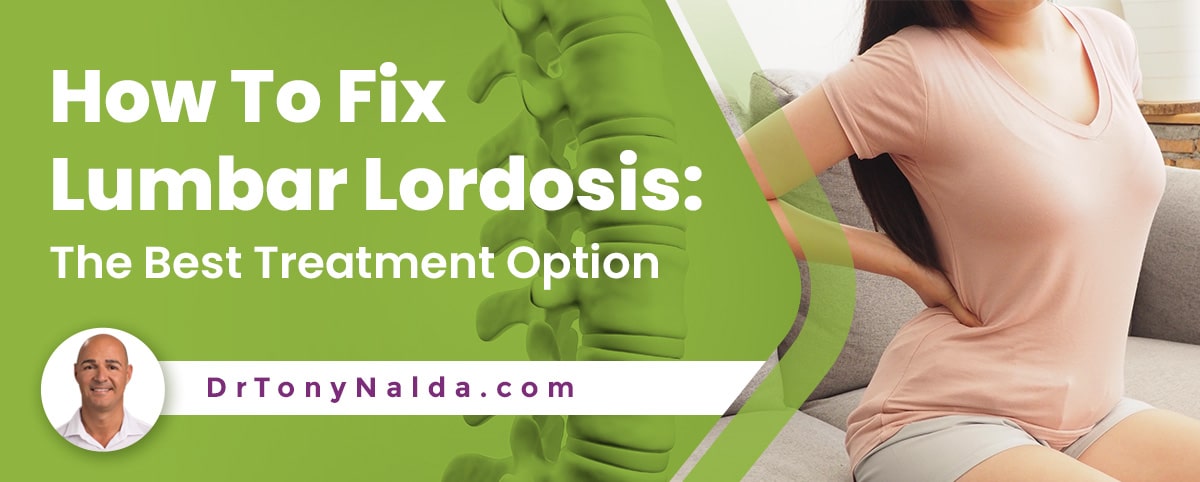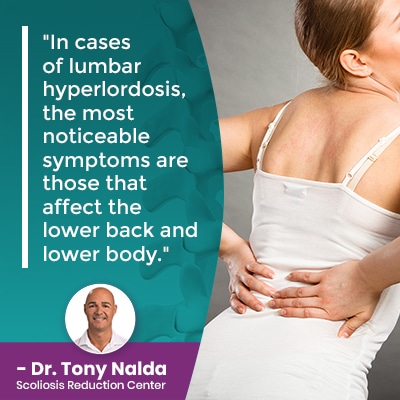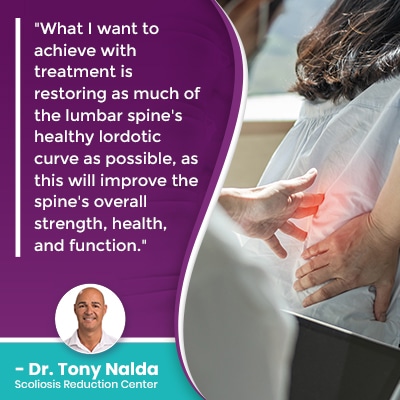How To Fix Lumbar Lordosis: The Best Treatment Option

A healthy spine that's functioning optimally as designed will have its natural and healthy curves in place, but there are a number of spinal conditions that involve a loss of those healthy curves, and lumbar lordosis, aka hyperlordosis, develops in the lower back.
If a person is diagnosed with lumbar lordosis, this means their lower back has developed an unnatural spinal curve that bends inward excessively. When it comes to treating excessive lumbar lordosis, plans have to be customized to address a condition's underlying cause.
Let's start our discussion of how to fix lumbar lordosis by first exploring the roles of the spine's healthy curves.
Table of Contents
A Healthy Spine
As mentioned, a healthy spine will be naturally curved in the right places, making it appear straight when viewed from the front and/or back and have a soft 'S' shape when viewed from the sides.
The spine facilitates the ability to stand upright, practice healthy posture, engage in flexible movement, protects important organs, and works in tandem with the brain to form the body's central nervous system (CNS).
The central nervous system is a complex communication network that enables essential brain-body connection, and this is why spinal conditions can cause such a wide range of symptoms felt not just in and around the back, but throughout the entire body.
The spine has three main sections: cervical spine (neck), thoracic spine (middle/upper back), and the lumbar spine (lower back).
The health of each spinal curve is dependent on the health of the others.
When the spine loses a healthy curve, it responds by putting in a bad curve, and the spine can also respond with the development of a compensatory curve; for example, if the lumbar spine has excessive lordosis, the cervical spine can develop an unhealthy curve in an attempt to counteract the uneven forces of the lumbar curve below.
So what are the spine's healthy curves, and how much of a range is there from person to person?
The Spine's Healthy Curves: Lordosis and Kyphosis
At each of the spine's main sections, there is a characteristic curvature type.
Lordosis (lordotic curves) are found in the cervical and lumbar sections of the spine, and these curves bend inwards, towards the body's center in a standard 'C' shape.
It's predicted that everyone will experience lower back pain at some point in their lives, and this is for the same reason that the lower back is particularly vulnerable to a number of spinal conditions/issues; the lumbar spine has to support the weight of the entire spine above, the trunk, and its vertebrae (bones of the spine) feel the effects of bending, lifting, and twisting motions.
The lumbar region is exposed to extra stress, and if an excessive curve develops causing the spine to bend inwards beyond a normal curve, problems can occur.
A natural range of lumbar lordosis would fall between 40 and 50 degrees, and if a person's lordosis falls beyond that healthy range, hyperlordosis is an issue.
Kyphosis is the opposite curvature type found in the thoracic spine, and this curve bends in the opposite direction: outwards, away from the body's center, in a reverse 'C' shape.
So what are the symptoms of lumbar lordosis?
Lumbar Lordosis Symptoms
While spinal conditions can cause a range of symptoms felt throughout the body, when it comes to an unnatural spinal curve, the area most likely to feel its direct effects is going to be the area that's closest to the affected spinal section.
For example, as the sciatic nerve starts in the lumbar spine and extends down the back of the lower body, an unnatural spinal curve in the lumbar spine can cause compression of the sciatic nerve, and sciatica can develop as a related complication.
 In cases of lumbar hyperlordosis, the most noticeable symptoms are those that affect the lower back and lower body.
In cases of lumbar hyperlordosis, the most noticeable symptoms are those that affect the lower back and lower body.
As hyperlordosis involves an over-pronounced inward spinal curve of the lower back, its most-noticeable symptom is the postural change it causes: a swayback appearance as the buttocks and abdomen protrude excessively.
Additional symptoms can include:
- Lower back pain ranging from mild to chronic low back pain
- Muscle pain
- Weak muscles
- Muscular imbalance
- Tight muscles
- Mobility issues
- Sciatic nerve pain
- Bladder control issues
- Numbness/tingling sensations due to uneven nerve pressure
Someone with structural lumbar lordosis will not be able to lie flat on the floor with their spine in contact with the floor because of the excessive inward curvature of the lower back.
It's not just the spine that has to maintain its natural curves; it also needs help from the muscles surrounding the spine, and when the spine is curved unnaturally, those muscles have to work harder, are pulled in different directions, and can become strained, weak, unbalanced, and sore.
It can be difficult for people with unnatural spinal curves to maintain a standing/seated position for extended periods of time, and participating in certain physical sports and activities can also become challenging.
So now that we have defined the condition and explored some of its common symptoms, let's move on to how best to respond to a diagnosis with lumbar lordosis treatment options.
Treating Lumbar Lordosis
When it comes to treating lumbar lordosis, as mentioned, a condition's underlying cause has to be addressed, and different types of lumbar lordosis have different causes: postural lordosis, neuromuscular, congenital, and post-surgical lordotic curves.
Here at the Scoliosis Reduction Center, the first step to designing a treatment plan for excessive lumbar lordosis is determining its underlying cause.
I work towards correcting unnatural spinal curves through integrating multiple condition-specific treatment disciplines such as chiropractic care and physical therapy.
 What I want to achieve with treatment is restoring as much of the lumbar spine's healthy lordotic curve as possible, as this will improve the spine's overall strength, health, and function.
What I want to achieve with treatment is restoring as much of the lumbar spine's healthy lordotic curve as possible, as this will improve the spine's overall strength, health, and function.
If a patient's lordosis is postural, it's likely that factors such as obesity and/or poor posture has caused the unnatural spinal curve, and as this condition is postural, and not structural, it is more simple to treat with a combination of lifestyle guidance, physical therapy science, strengthening exercises, hip exercises, and lumbar stabilization exercises.
In cases of neuromuscular lumbar hyperlordosis, there is a larger neuromuscular condition causing the development of the lumbar spine's excessive lordosis, so the underlying neuromuscular condition is the focus of treatment options.
If a surgical procedure or trauma experienced by the spine is the underlying cause, the injury/trauma has to guide the design of effective treatment plans.
Here at the Center, I combine condition-specific chiropractic care, in-office therapy, and custom-prescribed condition-specific exercises and stretches to work towards restoring as much of the spine's healthy curves as possible.
Chiropractic care includes manual adjustments that can work towards repositioning the most-tilted vertebrae back into alignment with the rest of the spine by addressing areas of vertebral subluxation.
Physical therapy science and exercise can help with strengthening the abdominal muscles and lower back muscles so they can optimally support and stabilize the spine.
A spine that's surrounded by strong muscles is one that has less pressure on its individual parts and is more capable of maintaining its natural and healthy curves.
Certain therapeutic condition-specific exercises and stretches are also known to improve brain-body communication for improved posture and body positioning.
Conclusion
The spine's natural curves are important, and there are a number of conditions that cause the development of unhealthy spinal curves, hyperlordosis being one of them.
There was a time when the place of exercise in the treatment of spinal conditions like hyperlordosis was questioned, but we've since learned that when combined with other forms of structural treatment, such as chiropractic care, physical therapy is an important facet of treatment.
As lumbar lordosis is excessive lordosis of the lumbar spine, once chiropractic care has impacted the condition on a structural level, a condition-specific exercise program can help by prescribing exercises known to strengthen and stabilize the lumbar spine and its surrounding muscles: hip flexor stretch, holding a plank position, corrective exercises, anterior pelvic tilt, etc.
Knowing the symptoms of lumbar hyperlordosis to watch for can be important for early detection and intervention, and applying a conservative chiropractic-centered treatment plan can help impact the condition on a structural level, increase muscle strength, and further stabilize the spine through a series of custom-prescribed home exercises.
When it comes to prevention, we're talking about the dangers of bad posture and weak core muscles, so be mindful of practicing good posture and a balanced body position, cultivate a healthy lifestyle that includes maintaining a healthy weight, activity level, and keeping the core muscles strong.
Dr. Tony Nalda
DOCTOR OF CHIROPRACTIC
After receiving an undergraduate degree in psychology and his Doctorate of Chiropractic from Life University, Dr. Nalda settled in Celebration, Florida and proceeded to build one of Central Florida’s most successful chiropractic clinics.
His experience with patients suffering from scoliosis, and the confusion and frustration they faced, led him to seek a specialty in scoliosis care. In 2006 he completed his Intensive Care Certification from CLEAR Institute, a leading scoliosis educational and certification center.
About Dr. Tony Nalda
 Ready to explore scoliosis treatment? Contact Us Now
Ready to explore scoliosis treatment? Contact Us Now





